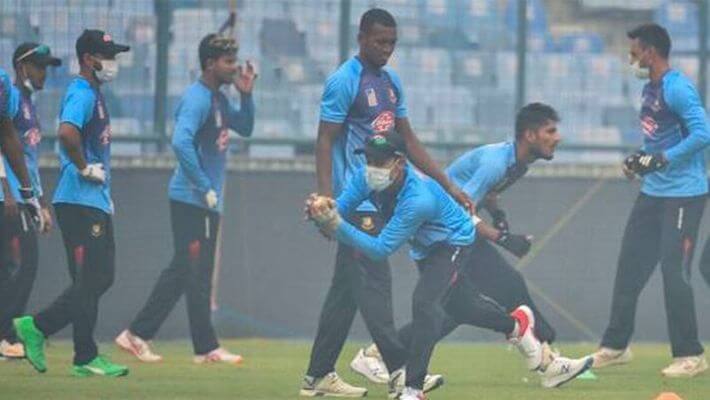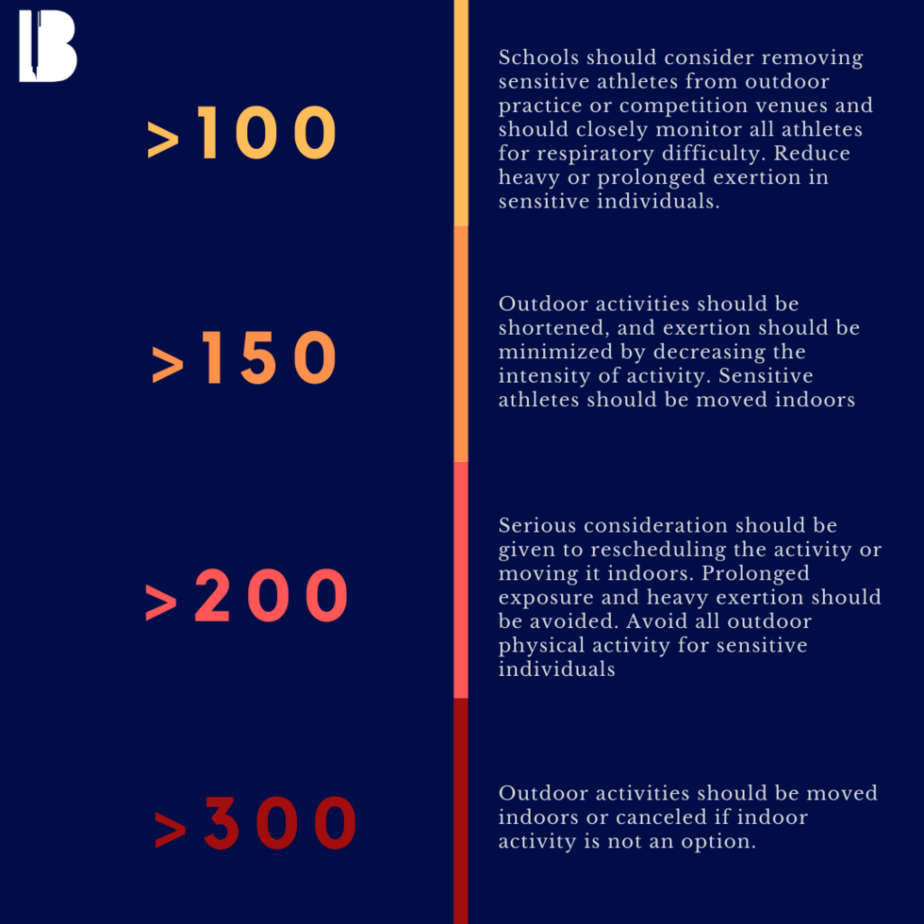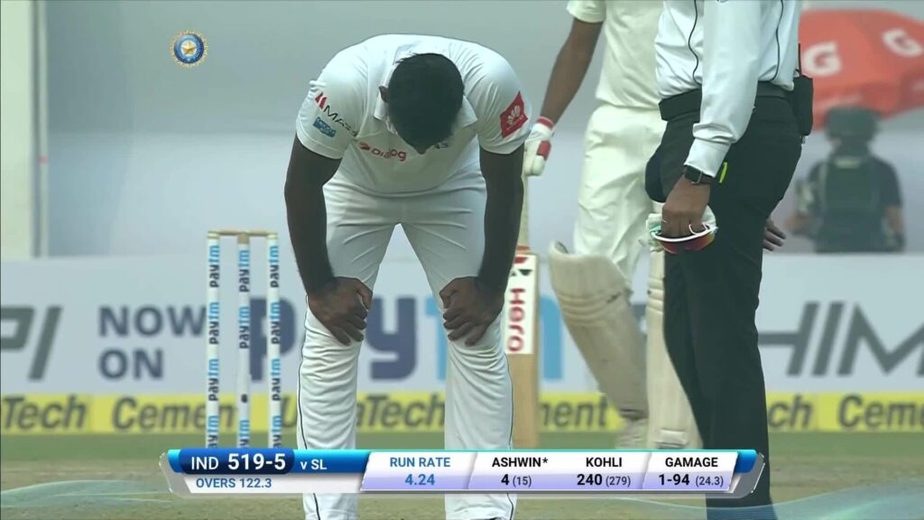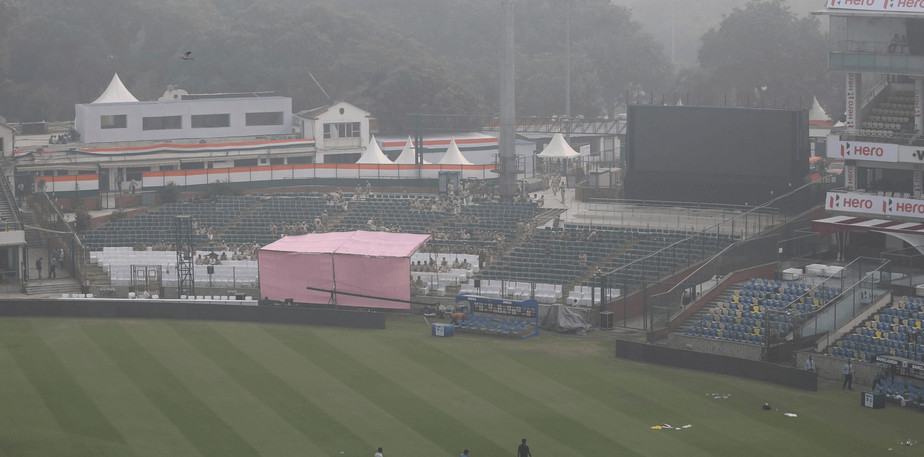Written by Sourya Reddy
The T20 between India and Bangladesh that was played on November 3rd, 2019 was a hazy one to remember. Not because of the fact that it was Bangladesh’s maiden T20 victory over India—that too at the newly christened Arun Jaitley stadium—but because of the hazardous blanket of polluted air that the players were forced to play under. Two Bangladeshi cricketers vomited on the field, sending reminders of the test match in 2017 between India and Sri Lanka that was disrupted by dangerous pollution levels. Then too, Sri Lankan cricketers took multiple breaks and vomited on the field. High altitudes and extreme heat are one thing for players to adapt to, but are we teetering dangerously close to normalizing toxic conditions that sportsmen are expected to play under?

Against the backdrop of the Delhi government’s public health emergency declaration, there were some calls to postpone the match or move it to a different venue. The Board of Control for Cricket in India (BCCI) and the Bangladesh Cricket Board (BCB) decided to continue with the match. “The weather has been magnificent. It’s not too hot. There’s no breeze. But not obviously perfect with the smog. But it’s the same for both the teams. It’s not perfect, not ideal. But we are not really complaining about it,” Russell Domingo, the coach of the visitors told reporters.
This decision to continue playing the match despite health advisories raises concerns regarding the BCCI’s responsibility towards its players and the role of sports as a platform in beating the air pollution.
Gauging the Impact of Air Pollution on Athletes
The impact of air pollution on health is well documented. Prolonged exposure can result in respiratory issues like Asthma and Chronic Obstructive Pulmonary Disease. Heart attacks, strokes, chronic kidney disease and cancer have also been reported with prolonged exposure.
Because athletes are put under intense physical strain, more damage is done to their bodies. Dr Gita Sinha, a public health expert and a member of Care for Air India, voices her concern, “By breathing more heavily and quickly with greater exertion, a sportsperson literally takes in a greater level of air pollution. It’s analogous to smoking a greater number of cigarettes in the same amount of time, compared to a non-sportsperson. Nothing filters out that pollution ingestion from a sportsperson’s body and there is no immunity for the effects of that level of exposure. As a result, we are concerned that a sportsperson who plays in the current levels of air pollution faces higher levels of health risk.”
The United States’ Environmental Protection Agency (USEPA) reported something particularly troubling; even when pollution levels are not particularly high, athletes can be affected because they inhale deeply, forcing air into their lower respiratory system where smog particles and ozone toxins accumulate.
Federations across the world have standards with respect to the conditions in which an athlete is supposed to train or a match is supposed to be held. Some, in fact, address air pollution directly. For instance, the National Collegiate Athletic Association (NCAA) — the USA’s college athletics governing body — has guidelines as to the level of training an athlete should undergo at specific levels of AQI, in accordance with those of the United States Environmental Protection Agency.

If a college-level body can be aware of the dangers posed by toxic air, then how does one of the world’s richest sporting bodies keep mum?
Protecting the Players
In the law of torts, there exists a concept called ‘duty of care’, which is simply an obligation to ensure the well-being of others. In the sports world, federations, as well as organizers of events, have a certain duty of care towards their athletes. However, the air pollution factor under this duty of care is not really spoken about.
In an email exchange with The Bastion, Nandan Kamath, one of India’s leading sports lawyers, shed some light on the concept of safeguarding athletes:
“Athlete safeguarding is reasonably new to sports administration and certainly to cricket and the process of expanding the scope of safeguards for athletes is panning out as a gradual and incremental process. Recent examples include the inclusion of concussion substitutes in cricket. Historically, umpires have called off matches where the pitch is deemed unsafe to play on. Similarly, teams have refused to tour in countries where travel safety is an issue. It is time that cricket also looks at environmental factors, including playing in polluted environments and in extreme temperatures”

It is one thing to say that the athlete has the choice and platform to raise their concern. “However, the issue is whether these concerns are factored in when making the ultimate decision and what the implications are of players not abiding by the federation’s decision,” says Mr Kamath. In all likelihood, especially in Indian cricket, players will not speak out against the federation. The power dynamic between the two is intensely tilted in favour of the regulators.
Consider the fact that Cricket has never had a player’s association until this year. Meanwhile, Indian footballers had a player’s association as far back as 2006. A players’ association is what can protect an athlete’s rights, give them a consolidated voice and represent their well-being. Such a platform is where discussions around air pollution can find some weight for cricketers.
“If the government is declaring a public health emergency, surely there is no other credible source we need to listen to?” says Dr Sinha. Yet, excuses for not postponing the match by a few days or to another location don’t really stand much ground. Granted, there are several parties that are involved in the process of conducting an international match — from both countries’ federations to advertisers, stadium audiences and broadcasters. They certainly have plenty to lose in the advent of a delay or cancellation.
But any decision-making process involves trade-offs and priorities. Consider the case that a match can be completely cancelled due to heavy rain. Surely, a public health emergency could warrant at least a delay in a T-20? One could say that the BCCI’s priorities vis-a-vis their players are clear for all to see.
Let’s Find an Answer
The first possible solution comes in the form of changing the structure of insuring matches. Matches are insured against things like rain and riot. For example, if there hasn’t been a single ball bowled under these conditions, the federation can be insured the full amount. If say, 20 overs are bowled, then around 50% of the insurance can be claimed and so on and so forth.
Adding air quality and pollution to this insurance list can make it easier for federations to consider cancelling matches. Kunal Dasgupta, one of the pioneers of the IPL and founder of Triplecom Media says, “there are lots of parties involved in hosting a match. On top of that, if a match is cancelled, neither the players nor the officials get their match fees. And then, of course, you cannot reimburse everybody who has booked a ticket to come out and watch the match. In such a situation, adding air pollution to the insurance list — which as of now, includes rain or riot — will make the decision to shift or cancel a match much easier”.
From the BCCI’s end, it should work on creating awareness and guidelines to reduce, to the best extent possible, the risk that athletes undertake.
“Beyond medical codes, sports’ leadership need to consider alternatives for when outdoor play or practice is not advisable due to air pollution. Who makes the decision to cancel or postpone a practice or an event? Using what source of information? Are there alternative practice regimens that can be done outdoors in that air quality, or shifted indoors? Are there alternative indoor venues with appropriate air quality? Is the practice and playing season going to have to shift venues or times of the year, to account for air quality? What are the emergency medical preparation and measures required for events to account for illness in air pollution? All of these kinds of questions warrant consideration and discussion, at the sports leadership level,” says Dr Gita Sinha
Javed, a player-manager, echoes the need for more awareness. “I think players need to be informed of the kind of impact that air pollution can have on you. I’m sure if they collectively demand a better understanding and incorporation of this issue, some change can happen. I mean, these guys don’t swear on their mothers or fathers; they swear on cricket, it is their whole life. So if you help build awareness of what they stand to lose because of being constantly exposed to air pollution, it would make it easier to come together and voice a collective opinion” he says.
As these questions are being asked and the feasibility of solutions being considered, it is necessary that this alertness trickles down to amateur levels, right down to our schools. Why? Well, because professional sport — especially so in the case of Indian cricket — goes beyond the duration of a match. Much revolves around the spectacle that sport beholds; the television and online viewership, the audience that comes to the grounds to watch their heroes in action, and the crazy fan-following are indicative of its influence in people’s lives. It is precisely within these quarters that the leaders of any sport have a duty to uphold. Federations, coaches and cricketers must signal to viewers around the world that air pollution is a danger that must be recognised and dealt with head on. Every sport has this obligation to its fans.
An emergency has been declared in Delhi due to the air pollution and people have been told to not go outdoors as much as possible. Also not undertake any strenuous activity. Cannot believe they are having a T20I here on Sunday, which is both outdoors and a strenuous activity ?
— Jonny Blu (@souls_asylum) November 1, 2019
“It sends the message that the sport cares for its community of players and supports them to play while safeguarding their health under the very real and harmful environmental conditions,” says Dr Sinha.
For sports fans and pundits around the world, India’s reluctance or delayed awakening to the dangers of air pollution in 2017 and 2019 should be a reminder of one infamous case — concussions in the USA’s National Football League (NFL). Despite the ample evidence of the dangers of concussions while playing American Football, the league took years and years to actually acknowledge the debilitating after-effects of the sport.
Concussions were proven to be caused due to the nature of American Football, regardless of where it was being played. In the same way, here, the safety of the players is paramount when breathing toxic air. At the end of the day, our continued reluctance to acknowledge the dangers of air pollution for cricketers poses a worrying question for the sports community: are we all complicit in allowing the BCCI to beat around the bush simply because it is easier to do so?






